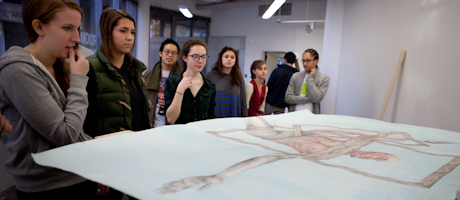When GW freshman Madeline Bouton first visited Classroom 102, the university’s student-run gallery space, she was struck by the gallery’s unusual shape: a trapezoidal room with a wall of windows, the space bisected by an interior wall.
“I thought, ‘This is such a weird space,’” she said. “It seemed very obstructive. And I started thinking about how the space itself could play a role in an exhibit.”
Ms. Bouton, a student in a Dean’s Seminar called “The Art of the Exhibition,” wasn’t just idly daydreaming. She and the 10 other students in the course were tasked with developing, curating and installing an exhibit for the gallery. And for the class—all first-year, first-semester students—the idea was both exciting and nerve-wracking.
“We’re the blind leading the blind,” Ms. Bouton said. “We’ve done a lot of reading and interviewing, but we’re still kind of making the rules up as we go.”
That’s by design, explained Bibiana Obler, an assistant professor of art history who developed and teaches the course. The idea behind the course, which, as a Dean’s Seminar, is open only to first-year students in the Columbian College of Arts and Sciences, is to take advantage of D.C.’s vast art and museum resources as learning tools, and then challenge students to apply what they’ve learned in a practical way. Through site visits to D.C. museums and galleries, readings and response papers, and discussions with curators, the students explore the responsibilities and challenges behind the exhibitions the public sees.
And while Dr. Obler provides guidance and suggestions, the students have been mostly on their own in developing their exhibition.
Each student submitted a proposed exhibit theme and the class discussed the feasibility and the appeal of each. Ultimately, the class decided on Ms. Bouton’s theme: obstruction. Then, drawing on what they had studied about curators’ responsibilities and goals, the students developed a plan to solicit art works for their exhibit both from artists within the GW community and from students at School Without Walls (SWW).
“In most museum exhibits, there is one curator, or maybe a few,” Dr. Obler explained. “Here, there are essentially 11 curators. A few students take on roles like team manager, but everyone has to agree about themes and what they want in the show. It’s challenging.”
The challenge was part of the appeal for JoVaun Holmes, a student in the course. Mr. Holmes is a member of GW’s Early College Program, which allows high school students from School Without Walls to earn a high school diploma and an associate of arts degree from GW concurrently. Mr. Holmes, who said he may be interested in a career as a curator some day, had considered taking a standard art history course this semester. But when one of his advisers recommended the Dean’s Seminar, he jumped at the opportunity.
“I really like the intimate experience of the Dean’s Seminar,” he said. “I’ve been able to open myself up and think about what I want to do for a career. I’ve wanted to get involved with the arts scene at GW, and in this class, our group is small and we really get into talking about our experiences.”
Because of his connection to SWW, Mr. Holmes has served as a liaison with the high school and has encouraged art students there to submit works to the exhibit. “Obstruction” will include six works by SWW students.
With most of the class time devoted to visiting galleries, hearing presentations from curators and other gallery personnel, and discussing readings about contemporary museum practices, the students put in a great deal of time outside class to develop their exhibit. They sought art works that dealt with the theme of obstruction as interpreted many different ways—psychological, political and physical, for example—and also developed gallery text to accompany each piece, publicized the exhibition and installed the pieces in preparation for the opening.
In keeping with the theme of obstruction, the students installed works hanging from the ceiling and obstructing visitors’ walking space. “By displaying art in unconventional ways—right in the viewer’s path—we force the viewer to look at art and space in an unusual way,” Ms. Bouton said.
Ms. Bouton, who is a project director for “Obstruction,” said she’ll judge the project a success at the end of the semester if it’s inclusive and collaborative. “I want a show where everyone in the class feels that they have a say and that they can contribute. We want a wide artist representation with varied works, and we also want the show to be cohesive and in keeping with our theme.”
For Dr. Obler, seeing her students become more confident talking and writing about art over the course of the semester is the main reward.
“It’s a different kind of class,” she said. “Over the course of the semester, they get a sense of the workings of museums and galleries. And these freshmen are so enthusiastic and engaged. My M.A. students tell me they want to take this course!”
An opening reception for “Obstruction” will be held Tuesday, Nov. 15, from 6 to 8 p.m. in Classroom 102, located in Smith Hall, 801 22 St., NW. After the reception, the exhibit will be on view Monday to Friday, 9 a.m. to 5 p.m., through Dec. 2.


